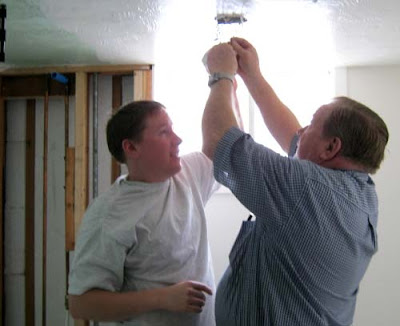In 1939, Paul
Kosok, a United States
scientist, flew in an airplane over southern Peru
shapes scratched
into the arid crust of the desert. Some of them were over 1000 feet in size and
had been preserved for more than 2000 years due to a complete lack of rain and
winds.
DH and I were
able to visit Nazca in 2007 with a group of people from the university where DH taught.
After a
two-and-a-half hour bus trip down the sandy Pan-American
Highway we were informed the weather at Nazca had been foggy for
the previous two days
so there was a
waiting list of people with reservations to fly over the desert ahead of
us. We were put on the bottom of the
list and informed that only about half of those who wanted to go would get a
turn.
We settled down
to wait. It was a great chance to catch up on sleep, read books or get better
acquainted with our fellow travelers.
Some wandered off to explore the town and found very little in the way
of stores near the hotel. Well, there
were stores, but they looked like something out of a bad western movie: very dark small and dirty.
Along with the ubiquitous
Coca Cola there was always
Inca Kola which tasted like super-sweet lemonade.
The minute we
left the safety of the walls around the hotel we were accosted by locals with
hand-made souvenirs for sale. I met up
with a mother and her little son and daughter, with small knitted figures
hanging from a tray. They had sold
nearly everything they had to the people ahead of me, but the price was so very
low that I couldn’t resist buying a little man, a woman and a llama. I indicated I wanted to take a photo of them
and they immediately struck several poses while I clicked away.
When it was
apparent that very few of our group would get time in the air over the Nazca
Lines we took a tour of some other sights in the town. We visited a shop where pottery was made. The
owner of the shop showed us how he used a smooth stone to polish the semi-dried
clay. Then he rubbed the stone on his
nose to use the oil from his skin on the stone to even out the surface. That, he told us with a wink, was why his
people did not have large noses like the Incas.
Next stop was a
gold refinery. They were using the most
primitive methods to extract gold from the red desert sand. There was a man with a white miner’s helmet
who showed us the process of panning and came up with some tiny, shiny
flakes. He showed us nuggets the size of
peas that he had found. He told use how
they used mercury to separate the gold from clay. Then he showed us
his sluice gate
which was a long wooden trough where water was pumped through sand to separate
out the gold ore. The power for the pump
was a skinny guy treading up and down on a seesaw device.
At the end of the day only seven of our group
got an airplane ride. Some of them didn’t
enjoy it much because they got air sick.
DH and I were disappointed in missing a once-in-a-lifetime chance to
see the Nazca Lines from the air.
We boarded the
bus for the return trip. As we rode back we watched carefully because we knew
the highway had been built across some of the lines and shapes on the desert
floor. Occasionally, for a moment, we
could see them a few yards wide disappearing into the distance.
We stopped at a tower
that had been built near the highway where we were able to at least get a look
at some of the designs.
Since it was
late in the day the low angle of the sun helped us see the ancient artwork on
the largest drawing tablet in the world.
After DH and I had taken our turn on the tower we waited in the sandy
parking lot by the bus. I wandered
around and kicked up some rocks and picked up a heavy black one as a
souvenir. Then I noticed something dusty
and smooth with sharp edges. I was sure
I had found a piece of prehistoric pottery.
I flipped it over and blew off the dust.
The words “Inca Kola” were printed there on a blue label.
I kept it anyway.




































